Ken Anderson is considered by many to be the father of the Haunted Mansion due to his early involvement in the development of the project at Disneyland. It only seems fitting that during the Mansion’s 50th anniversary month a panel entitled “Ken Anderson’s Haunted Mansion ’57: A Year of Horror, Humor, and… Voodoo?” was put together by Jeremy Marx of the Disney History Institute at the D23 Expo 2019. What really made this panel special were scans of Ken Anderson’s personal collection of Haunted Mansion concepts. Of the documentation for his Haunted House project, there were 14 scripts, over 200 notes, and over 150 images!
I could sit and listen to Jeremy talk about this subject for hours and not get bored. The stuff he was able to cover in just one hour was simply incredible (and there’s still so much more). My sincerest thanks to Jeremy and the Disney History Institute for supplying most of the images for this article. A lot of what was shown in the panel were not from the Disney Archives, as I mentioned before, so it’s a huge treat that we can include them here.
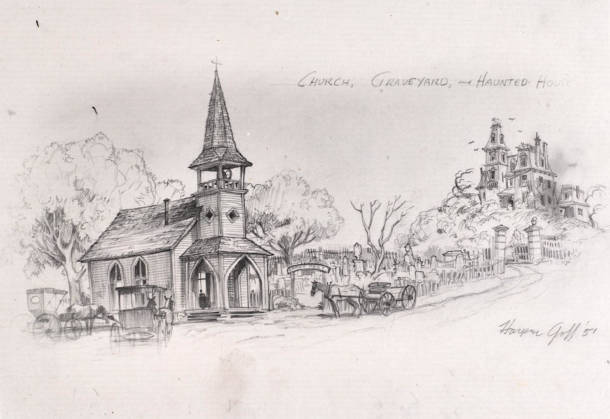
The idea for a Haunted House attraction at Disneyland was tossed around quite often in the early development of the theme park. There’s an infamous sketch of a church, graveyard, and haunted house drawn by Harper Goff that’s dated 1951. Jeremy showed us a scrap of paper listing all the attractions in 1956 that were planned or in development at the park and at the bottom, handwritten in (maybe by Ken Anderson), was “Haunted House.” Yes, Haunted House (or sometimes “Ghost House”), what Jeremy was showing us was well before Marc Davis and Sam McKim.
Using all the notes, Jeremy was able to create a rather clean timeline, making it easy for us to follow. You could really see Ken Anderson’s creative process through each revision of the script. Throughout the panel, it was easy to pick out where so many of the things we see in the Mansion today came from.
Early ’57 – The Ghost Bride and Voodoo
One of the first pieces of a script that Jeremy showed us was dated February ’57. This early on, there was to be only one ghost that haunted the house: the bride, Priscilla. Your guide was named Beauregarde (remember, this was originally meant to be a guided tour), and he would take you through the house while explaining the story of what happened there. Even that early in the development, a portrait gallery was present. There, the guide points out a painting of the owner of the house who has an “evil eye.” Indeed, the painting did as well, as the painting would change.
Throughout the attraction, the ghost bride would show up and ask “where’s Bartholemew?” Bartholemew was going to be her husband and the guide was to explain that the master was on a trip, but hasn’t returned.

Jeremy went over one scene with Priscilla being told to not open up a chest, and then promptly finding the key and opening it. Then the Pirate Captain Gore, her husband and whom the chest belongs to, would appear from behind a panel and the room would cut to black.
Another interesting scene included the guide touring the guests to a room overlooking a graveyard. It’s there where he explains that he’s been with the family for many years at which point a blacklight would turn on and reveal his skeletal form.
When you would reach the Captain’s room, the guide would explain that the Captain can’t sleep well anymore and sleeps with two pistols in his hands. The ghost bride shows up and of course, he shoots through her.
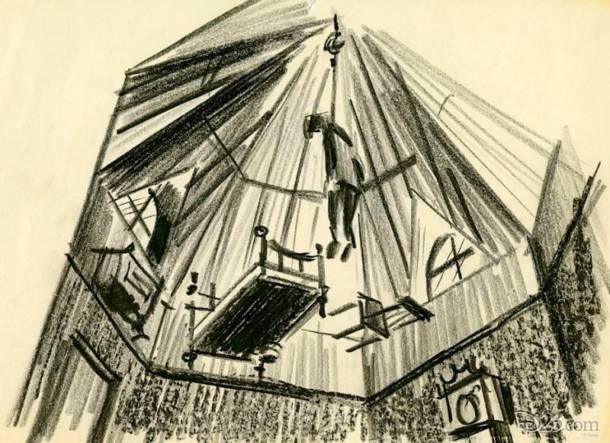
At the end of the guide’s story, no one knows what happened to Priscilla, the bride, or the Captain. A lightning flash, everybody looks up to see a body hanging from the rafters (the captain’s), but as we’re leaving we hear Priscilla’s maniacal laughter. If you’re counting, that’s two of the most iconic scenes in the Mansion that were part of one of the earliest scripts, and who knows if the hinting that the bride was evil influenced the scene we have with Constance in the attic today.
To help establish backstory, Anderson thought that maybe he would include newspapers pasted to the front gate of the property. Jeremy had illustrations and suggestions of what these could’ve been. Guests could go read bits and pieces of the stories related to the house. One article included something about a ghost disintegration pistol.
Apparently, Jason Mason and Peter Lorre were originally considered to be the narrator. Jeremy went on to play a small clip of Peter Lorre reading Edgar Allen Poe’s The Black Cat on the radio to demonstrate what kind of eerie tone Lorre could’ve set. You can listen for yourself with the embedded radio drama below (it’s queued up at the clip Jeremy played).
Another script included a reference to a woman being pulled into the darkness by a man’s arm. Anderson had a completely different backstory this time. That arm belonged to a servant named Tor and his job was to keep the bride locked up in the tower while the master was away. The story went on that Tor grabbed her and accidentally strangled her to death. Realizing he killed her, Tor then takes his own life. The commodore (master of the house) was also killed at sea, forcing him to spend the rest of eternity begging his bride for forgiveness, but never in time to stop the reenactment of the bride’s death. Pirates and sailors seemed to be a common idea in Anderson’s early ideas.

At one point, the butler guide is taken away and the commodore’s voice says “look up at the ceiling.” Lightning flash, dead body hanging from the rafters, but it’s the butler’s body this time. “Let that be a fair warning to all unwelcome visitors.” Seems Anderson really liked the suicide reveal, it went through a lot of changes.
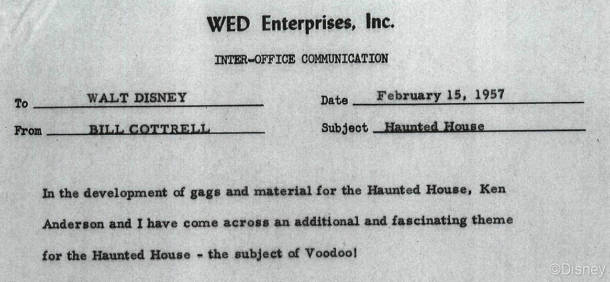
Jeremy then brought up a memo to Walt Disney where the subject of voodoo was introduced. It was suggested that the story would then be that the villain would be the bride who turns out to be a voodoo queen. She puts an effigy on her husband who is driven by fear to suicide. They really did their research it seems, Jeremy had several memos about books, notes, and more on that subject being sent back and forth.
Another revision and a front porch bullpen was added. It’s here that a recorded introduction would play, removing the guide from the beginning. The story changes this time were that the bride goes missing instead of being murdered. The commodore locks down the house and spends his entire life looking for her, turning himself into a zombie. Now the guide is carrying that disintegration gun mentioned earlier as he’s giving you the tour, disintegrating ghosts as the tour carried on.
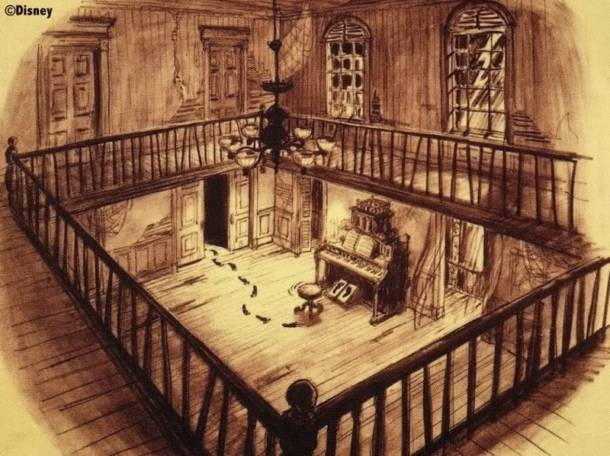
In another script, Jeremy noted one new concept: humor. In one room an organ is playing and the host says “oh look, the Haunted House Five Plus Two are at it again!” Humor comes up often, contrary to popular belief, it seems like Ken didn’t seem entirely against the idea.
Spring ’57 – Operational Research
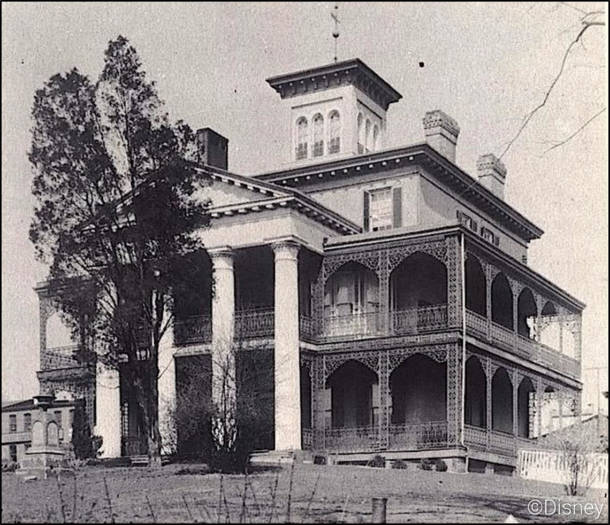
In March of ’57, there’s mention of the first room having a chandelier and the ghosts are sawing it off as you walk underneath it. After April, though, Jeremy didn’t have anything in Anderson’s collection for several months. Anderson was working on things during this time because that’s when he found the Shipley-Leydecker house and drew that wonderful illustration that would later have a paint-over by Sam McKim, becoming the most iconic concept artwork of the Haunted Mansion.
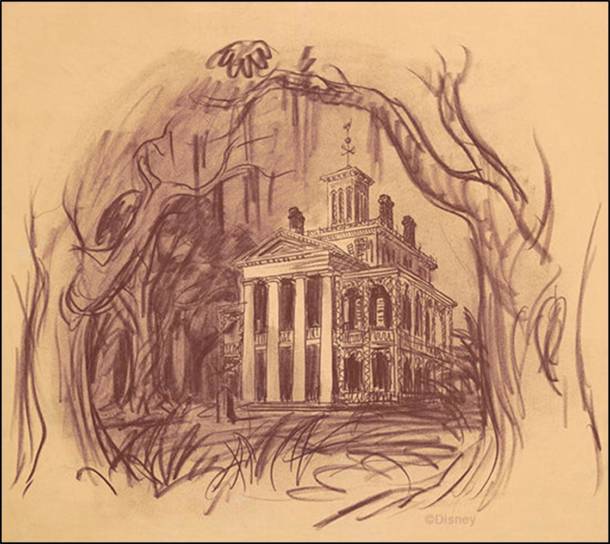
This is also when Anderson visited the Winchester House. Anderson made notes of capacity measurements, saying that 35 people would need to be taken through at a regular interval of 1.5 minutes (which, obviously would never have happened). This would’ve lead to a rather poor hourly capacity of 1,400 people an hour. They would’ve only theoretically been able to push 14,000 people through the house in a 10 hour day. The Omnimover system that came later can theoretically push around 3,200 people through the Mansion an hour, more than twice as many.
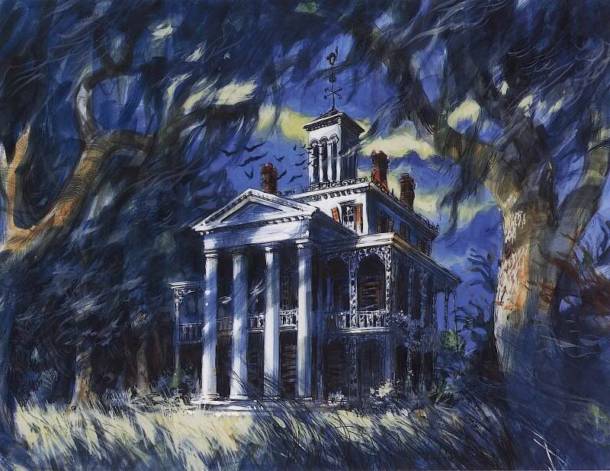
Summer ’57 – A Firm Foundation
From August ’57, Jeremy has another script that references a trick that would require guests to sign a register which would later be used to recognize guests during their tour. I immediately thought of the E.T. ride at Universal Orlando where E.T. says your name at the end.
The script then goes on to mention that Walt’s voice would be the one you hear outside the house, giving you the introduction. This is also the first mention of a narrator being more extensively used instead of a guide. The guide is actually ripped away from you right at the beginning and Peter Lorre’s “Lonesome Ghost” would be your guide. Then Jeremy showed us a memo that was pretty cool. At some point, they were conducting tests of 40 people walking through the Zorro sets to see if any of this worked.

Now’s when things got really fun. Jeremy shows us a major revision dated September 17th, 1957 that’s 23 pages of “awesomeness,” as he described it. It has scripts, images, drawings, architectural illustrations, and even a blueprint with exact measurements of how this thing was laid out. Jeremy showed us an illustration of the front of the house with the Jungle Cruise on the left, giving us an idea of where Anderson had planned on putting it at the time.
Because it’s so detailed, Jeremy actually 3D modeled and recreated each individual scene to scale so we could see what it might’ve looked like. Considering his history doing VR ride throughs, I hope he uses the models for that purpose in the near future, but he’s shared a few of the images here.

Oh, and those tests on the Zorro sets? This entire blueprint was mocked up and tested with groups of 40 people. Wouldn’t you have liked to be in that test group?
Here’s a bullet-point style list of each room:
- Ticket Booth is the gatehouse to the property. Overgrown gardens, moss, and as you round the corner the house appears. It’s run down and dilapidated.

2. Get closer to the house and a woman screams from the window and grabbed by a big hairy hand.
3. Front Porch bullpen. It’s 44×10. Walt’s voice addresses the group, the narration is much longer than the 1.5 minutes they’re looking for. Narrator’s story is full of tragedies, plenty of people have disappeared.

4. Entry. Rickety stairs going up three floors, chandelier being shaken by a ghost, a wall where a ghost is writing “Mortals, go home.” The guide walks through a section of a wall and says “don’t worry folks, he’s only a ghostwriter.”
5. Portrait Hall. 24×8 (how do you fit 40 people in this?) with 16ft rise. 6 portraits watch you as you walk up ramp. Guide talks about the owners hosting a wedding for their daughter, the wedding is prevented, the ghosts re-enact the wedding every year and if it does finish, the curse on the house is lifted.
6. Library. Room where the Lonesome Ghost is. The other ghosts don’t like him because he likes humans more than his own kind. The mirror displays an image of the Lonesome Ghost floating around the room. Exit room through a secret passage, Hairy the Arm (that’s his actual name in the notes) tries to grab your guide.
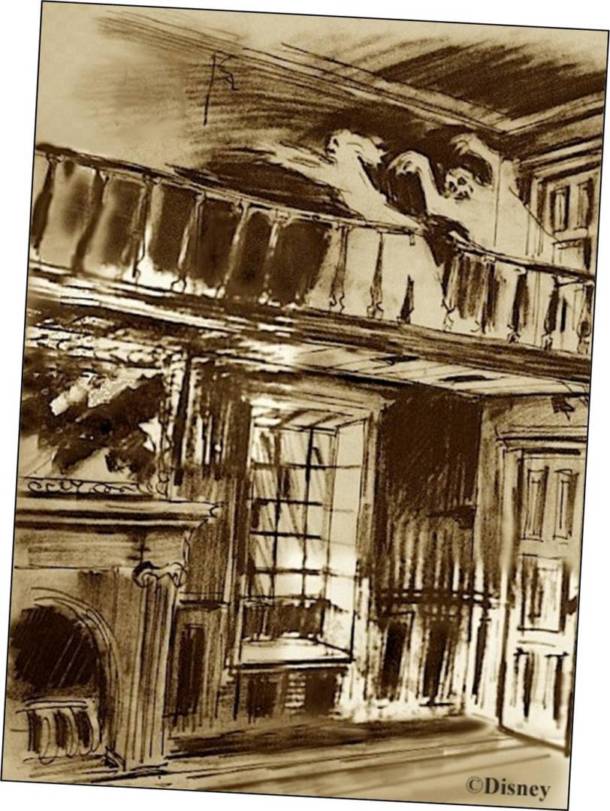
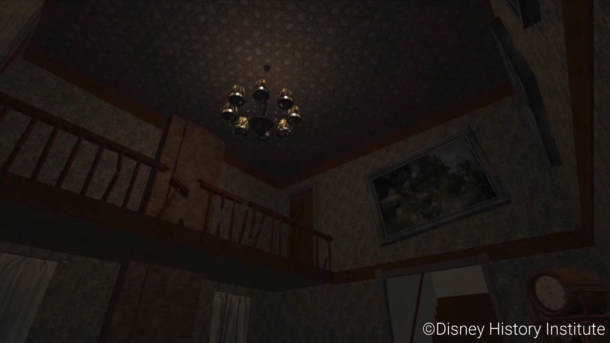

7. Gallery. 2 stories, balcony, staircase. A woman strides across balcony screaming bloody murder. At the top of the stairs, her head falls off and, screaming, bounces down the stairs. Lonesome: “Well I hope she can pull herself together before the wedding.” Another secret passage out.

8. Bedroom. Lights dim, child-sized monsters in bed scream “eek people.” Room comes to life, green fire in fireplace, a rocking chair starts to rock on its own, then Lonesome can be seen in the bathroom washing his invisible body. Guide is grabbed by Hairy the arm. He opens a door elsewhere in the room and says he got away.
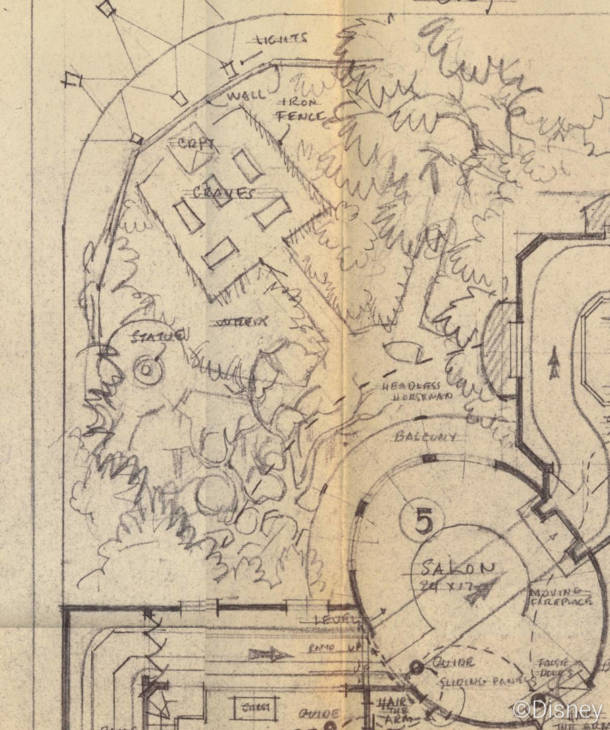

9. Salon. Domed ceiling, broken bay window overlooking family graveyard. Ghosts are coming out, including the Headless Horseman. Hairy the arm has moved a fireplace 10ft off the ground to prevent the tour from moving around, a different route is taken.
10. Tower. Dark, empty pit in the middle (octopus may have been in there at one point, but not in this script). Windows with rain and ghosts passing by.
11. Hallway to drawing room. Mirrors on each side. As you’re walking, ghosts are walking with you.
12. Drawing room. Mirrors are on all sides (at least the 6 ones that aren’t doors). Ghosts are walking around the room. Lonesome, about the bride: “I wonder where he dug her up.”

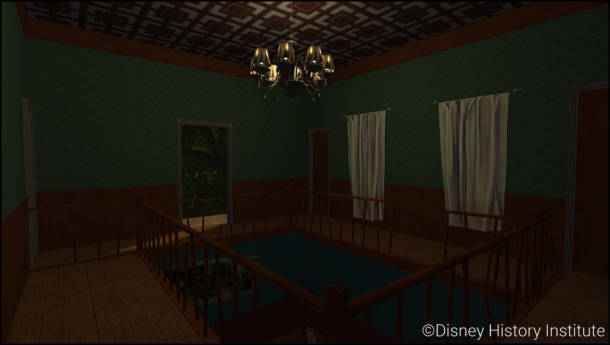
13. Great Hall. Overlooking a room below. Table with cake, everything’s covered in cobwebs. Bride and Groom meet up, Groom takes her head off her shoulders and kisses her, she smacks him. Reaction with thunder, lightning, and the ghosts going “oh no.” The scene replays over and over, faster and faster, and guide pushes to leave.
14. Ramp out. 10×4.5 (tight space). About 6 feet of ramp to go back down.
15. Trophy Room. Guide opens a sliding door in the fireplace.
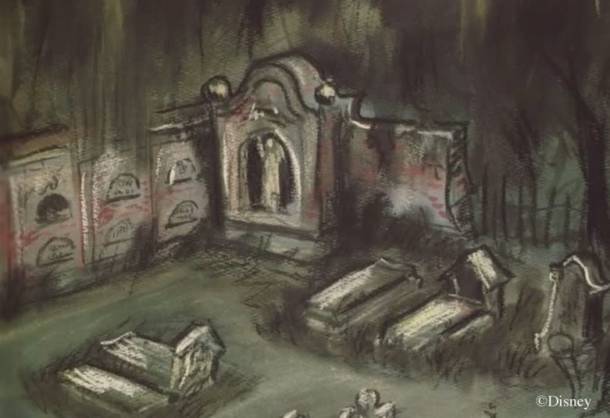
16. Passageway, another door, then outside. No rain, no storm, it’s beautiful. Guide tells group to go check out the family crypt, then a bloodcurdling scream, Hairy the arm grabs him and pulls him back into the house.
So at this point, Ken Anderson had a great script to use as a base and now could focus on how to pull it off.
Fall ’57 – Illusions
Jeremy had memos and notes from October when Ken Anderson and Claude Coats went to Nela Park to ask how to accomplish the effects they wanted to do. Ken had 10 pages of notes, all of which were mostly questions (and answers) about things like “how many lights would you recommend for this effect?” Anderson had even considered attempting exterior lighting during the day in an attempt to darken the outside of the house.
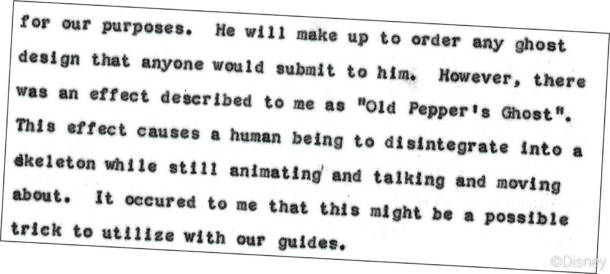
They also visited a company called Nelson Enterprises, a place that focused on supplying haunted houses around the country. This is where they learned of a cool trick called “Pepper’s Ghost.” Yes, that now-infamous trick used in the ballroom of the Haunted Mansion. Anderson purchased a kit and now had a really convincing illusion. Now he could’ve done that trick with your guide turning into a skeleton with Pepper’s Ghost.
Continuing on, notes and illustrations demonstrated how Anderson intended to pull off the Headless Horseman. Projectors, wireframes, how they would mount it, etc. I’m assuming he was looking to do it in a similar way to how the Hatbox Ghost was originally done.
Now, how to light these rooms? Anderson had considered lighting through cracks in the floor and ceilings, how eerie. I get the feeling that these rooms were intended to be much darker than you might’ve anticipated.
Winter ’57 – The Lost Script

Jeremy explained that there’s a script from late ’57 that has illustrations (the one above), but one that he couldn’t find. The illustration was the first mention of some sort of vehicle made of 2x4s, railings, and wheels. Fortunately, Jeremy had a clip from an interview with Ken Anderson in 1992. Let me tell you, what an incredible thing to be able to hear Anderson himself explain exactly what he had planned at the time.
Anderson explained that in this revision when you entered the house, the guide would tell you that they couldn’t build anything in this house, the ghosts won’t let them. You’ll be standing on this contraption (the 2×4 vehicle, it’s essentially a giant piece of scaffolding that holds 40 people). Again your guide would be snatched by a ghoul in the beginning and the Lonesome Ghost would be your guide. Anderson mentioned a scene where you’re actually led outside into the garden, which has tombstones, bats, and it’s nighttime outside (meaning if it was daylight outside, it’s now nighttime inside). I’m really hoping this interview is released publicly, I’d love to hear more of the details. It was interesting to hear that Ken had already decided this thing needed to be a ride to fix the capacity problem, though.
After listening to Ken Anderson, Jeremy went back to explaining how the tests on the soundstages worked. The simple answer is that they didn’t. Not only was it operationally a nightmare and low capacity, but Anderson stated that he wanted to “scare the living hell out people so they never ever come back to this building again.” Of course, that wouldn’t work in a theme park setting where Walt wanted people to go back to attractions over and over again.
I’d like to end with the same quote that Jeremy used. He quoted Ken Anderson saying, “… it seemed to me it was a hunted house; I couldn’t see it being funny. But Marc Davis, and Sam McKim, and some of these people came in, and they took over from our sketches that we had done before, five years before, and then they built on those with their ideas to make it funny … and they did!”
There’s even more to this story, things we may not even know yet. After listening to Ken Anderson’s ideas for a while, you can really see just how influential he was to the final Mansion, his ideas were that good. What was the most interesting part of the revisions to you? Let us know in the comments.
Disneyland Discounted Ticket Opportunity! Adults for the Kids Price
Get Away Today has a very limited time MiceChat offer that we don’t want you to miss out on. If you book by the end of Monday (Labor Day) adults can get Disneyland tickets at the kids price for travel through the end of this year! Details for this special MiceChat offer HERE
If you liked today’s story, please check out Disney History Institute, they were the ones who put the D23 Expo panel together and supplied me with the photos. Our deepest thanks!




You must be logged in to post a comment.